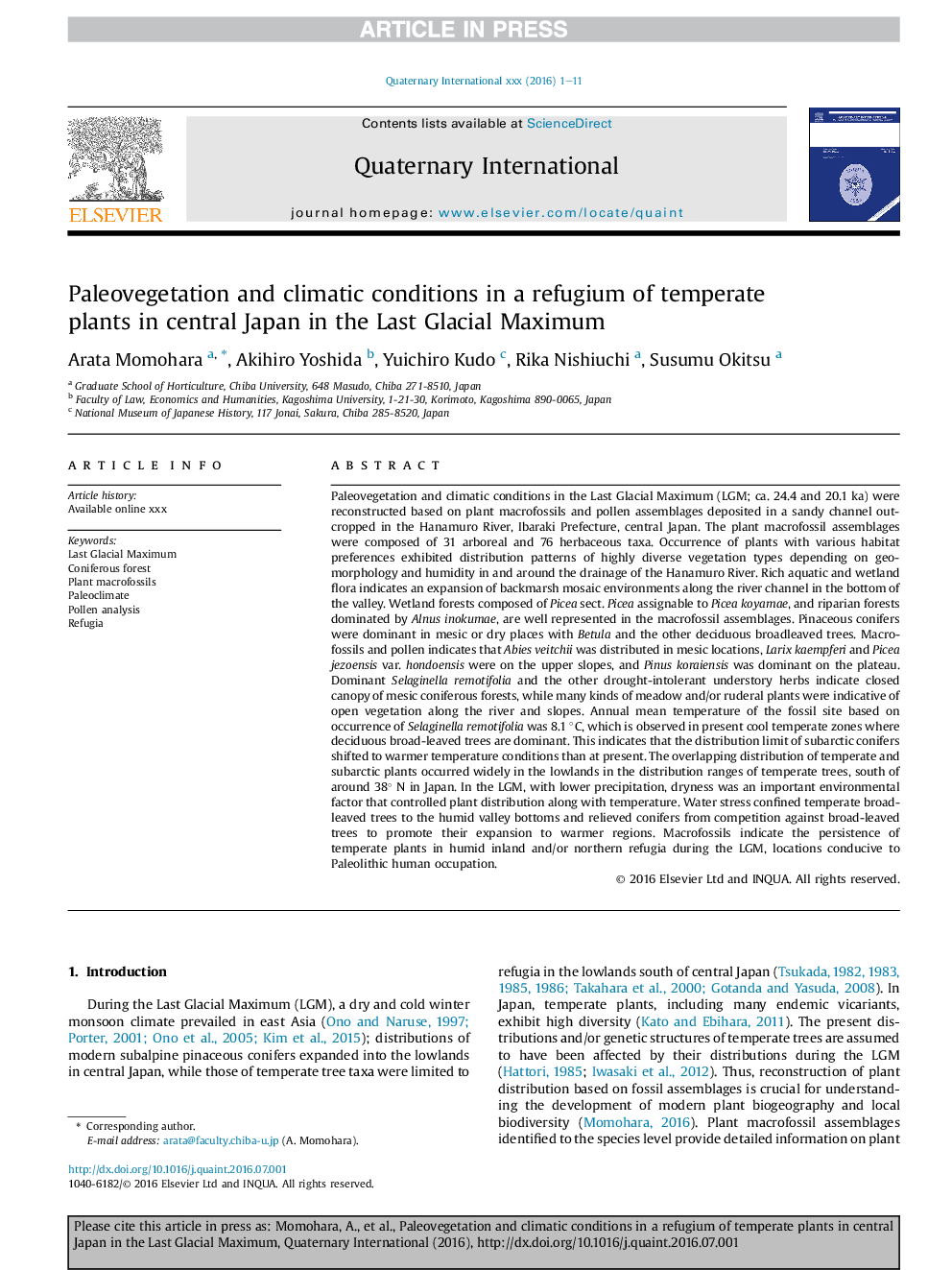| کد مقاله | کد نشریه | سال انتشار | مقاله انگلیسی | نسخه تمام متن |
|---|---|---|---|---|
| 5114002 | 1484082 | 2016 | 11 صفحه PDF | دانلود رایگان |
عنوان انگلیسی مقاله ISI
Paleovegetation and climatic conditions in a refugium of temperate plants in central Japan in the Last Glacial Maximum
ترجمه فارسی عنوان
زادآوری و شرایط آب و هوایی در یک رگهای گیاهان معتدل در مرکز ژاپن در آخرین حداکثر یخچال
دانلود مقاله + سفارش ترجمه
دانلود مقاله ISI انگلیسی
رایگان برای ایرانیان
کلمات کلیدی
موضوعات مرتبط
مهندسی و علوم پایه
علوم زمین و سیارات
زمین شناسی
چکیده انگلیسی
Paleovegetation and climatic conditions in the Last Glacial Maximum (LGM; ca. 24.4 and 20.1 ka) were reconstructed based on plant macrofossils and pollen assemblages deposited in a sandy channel outcropped in the Hanamuro River, Ibaraki Prefecture, central Japan. The plant macrofossil assemblages were composed of 31 arboreal and 76 herbaceous taxa. Occurrence of plants with various habitat preferences exhibited distribution patterns of highly diverse vegetation types depending on geomorphology and humidity in and around the drainage of the Hanamuro River. Rich aquatic and wetland flora indicates an expansion of backmarsh mosaic environments along the river channel in the bottom of the valley. Wetland forests composed of Picea sect. Picea assignable to Picea koyamae, and riparian forests dominated by Alnus inokumae, are well represented in the macrofossil assemblages. Pinaceous conifers were dominant in mesic or dry places with Betula and the other deciduous broadleaved trees. Macrofossils and pollen indicates that Abies veitchii was distributed in mesic locations, Larix kaempferi and Picea jezoensis var. hondoensis were on the upper slopes, and Pinus koraiensis was dominant on the plateau. Dominant Selaginella remotifolia and the other drought-intolerant understory herbs indicate closed canopy of mesic coniferous forests, while many kinds of meadow and/or ruderal plants were indicative of open vegetation along the river and slopes. Annual mean temperature of the fossil site based on occurrence of Selaginella remotifolia was 8.1 °C, which is observed in present cool temperate zones where deciduous broad-leaved trees are dominant. This indicates that the distribution limit of subarctic conifers shifted to warmer temperature conditions than at present. The overlapping distribution of temperate and subarctic plants occurred widely in the lowlands in the distribution ranges of temperate trees, south of around 38° N in Japan. In the LGM, with lower precipitation, dryness was an important environmental factor that controlled plant distribution along with temperature. Water stress confined temperate broad-leaved trees to the humid valley bottoms and relieved conifers from competition against broad-leaved trees to promote their expansion to warmer regions. Macrofossils indicate the persistence of temperate plants in humid inland and/or northern refugia during the LGM, locations conducive to Paleolithic human occupation.
ناشر
Database: Elsevier - ScienceDirect (ساینس دایرکت)
Journal: Quaternary International - Volume 425, 15 December 2016, Pages 38-48
Journal: Quaternary International - Volume 425, 15 December 2016, Pages 38-48
نویسندگان
Arata Momohara, Akihiro Yoshida, Yuichiro Kudo, Rika Nishiuchi, Susumu Okitsu,
